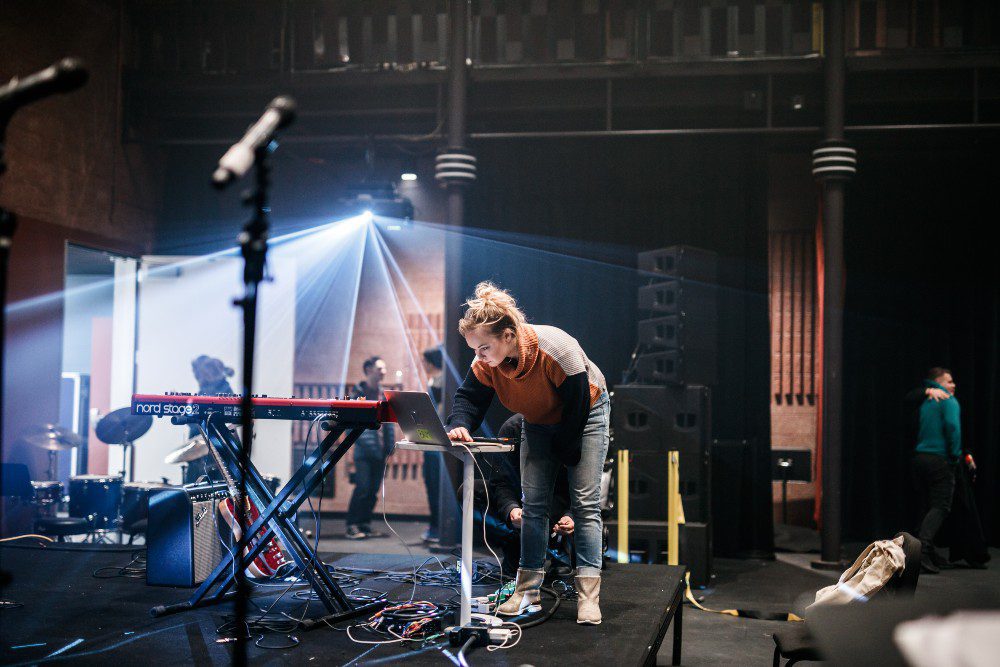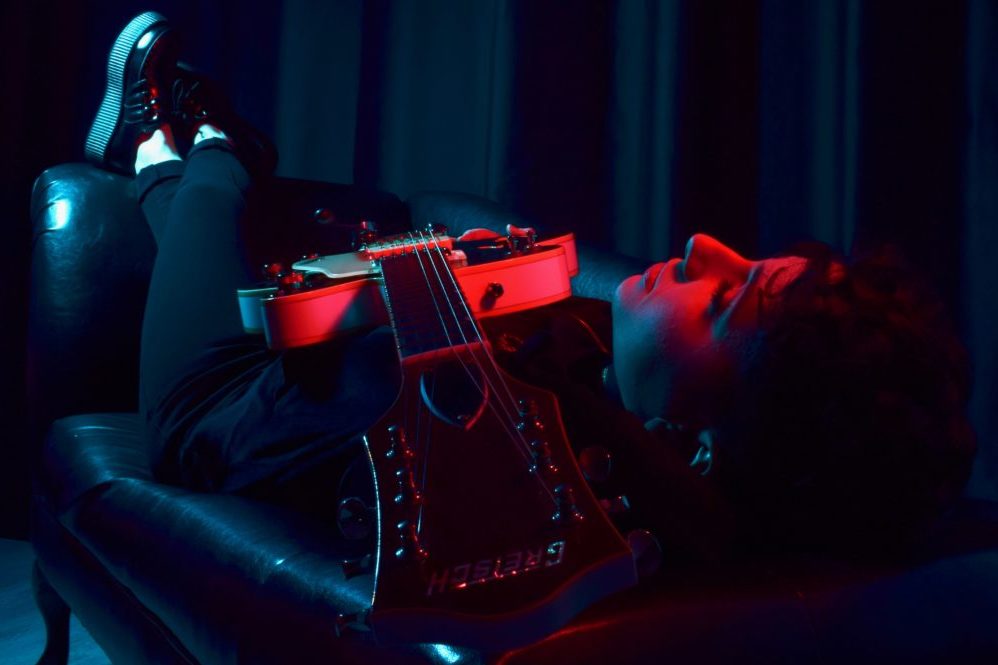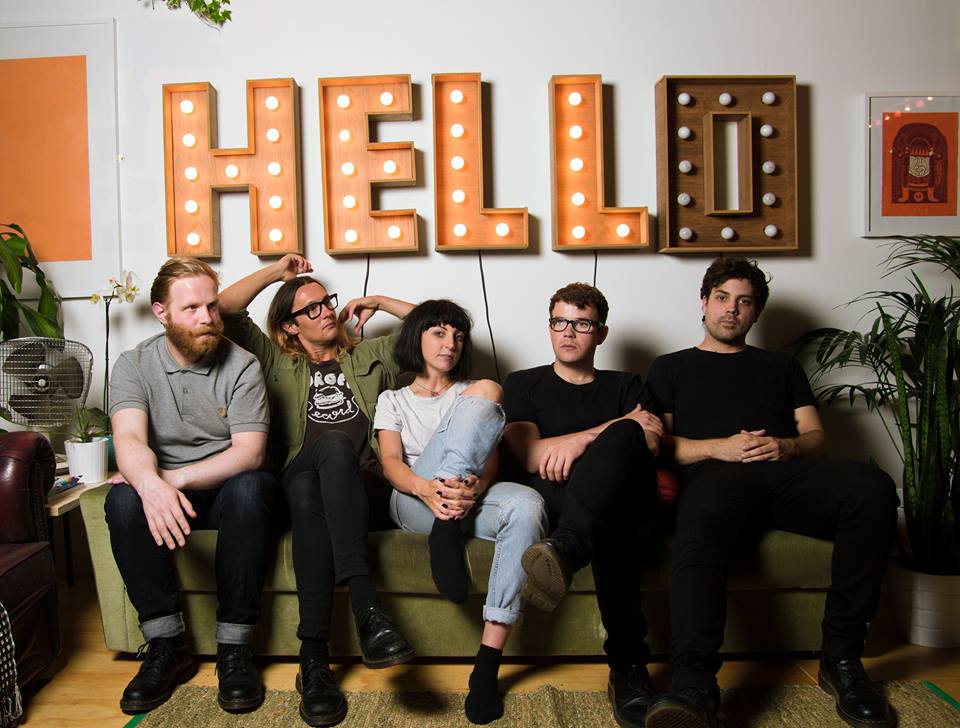

Bella Blasko started her music industry career as a studio intern, but a decade later, she has paved her way as an internationally traveling audio engineer, producer, and mixer, working with some of the biggest names in music. Her approach of intuition and flexibility has led her into rooms recording not one but two records recognized at the 2021 Grammy Awards: Bonny Light Horseman’s self-titled release, nominated for best Folk Album; and Folklore, Taylor Swift’s collaboration with Aaron Dessner of The National, which took home the award for Album of The Year.
Blasko’s accomplishments are particularly noteworthy considering that women only make up 5% to 7% of producers and audio engineers, as reported by the Audio Engineering Society. Throughout the setbacks of 2020, Blasko has remained an in-demand studio wizard nestled in the Catskill mountain region of The Hudson Valley. I Zoomed with Blasko to discuss her humble beginnings, learn some tips, and walk her fantasy-like journey navigating and succeeding in the competitive, male-dominated world of audio engineering.
AF: How did your musical path lead you to the world of audio engineering?
BB: I grew up in New Hope, Pennsylvania, outside of Philadelphia. I started playing piano when I was really young, around six or seven, and then studied classical piano all the way through college. I didn’t really expect to do that, but at some point, I realized it was the thing that I loved the most. I transferred to Bennington College in Vermont my sophomore year, and was interested in taking recording classes with Julie Last. When I met Julie, she was super inspiring to me and made me realize it was what I wanted to do. At the time I didn’t realize having a female role model in that position was so rare. I was so lucky to study with someone I really connected and related to. She made me feel like audio engineering was something I could do, and envision a place for myself in that world.
AF: How would you describe your first professional studio experience?
BB: My first studio internship was at the Clubhouse in Rhinebeck. It’s an awesome studio and it was a really great place to learn and get hands-on work. It can be difficult and competitive getting an actual job out of an internship because there aren’t many positions at a studio, and most artists bring in their own engineers for sessions. The timing worked out for me because an assistant engineer was leaving as I was arriving, so I worked really hard to learn everything so I could take over their position. I also worked at another studio outside of Woodstock called Dreamland. It was a pretty quick transition for me to go from intern to engineer. Being an assistant is all about making things happen the way the artist wants it to happen. You have to learn to be flexible in your approach, while knowing the gear and console inside out. I guess I just learned everything hands-on by paying close attention.
When I was first an intern, I remember going into the studio, seeing a giant patch bay and thinking, how am I going to learn that? What even is that? Early on, I’d stay in the studio after the session and look at how everything was patched and how different engineers or producers would have things routed, then try to study and internalize it. A lot of assistants might just set something up for someone without thinking about why they’re doing it that way, or what’s good about it. It’s so important to pay attention to details like microphone placement, because a slight angle can make a huge difference. Paying close attention over time gave me a set of tools. Once I started running my own sessions, then I could try to figure out from that toolbox, what’s my own style? What do I like? Which sounds do I prefer?
AF: What’s your preferred digital audio workstation?
BB: I primarily work in Pro Tools. That’s the standard in most professional recording studios these days. It’s what I’m really comfortable in and that’s also a helpful part of becoming an engineer, getting really fast and proficient in your program. I also do a bit of Ableton, which I’ve just gotten into more in the past few years when I was helping build some Ableton rigs for live shows.
AF: Can you talk a bit about your work with live shows?
BB: I was helping Aaron Dessner from The National a lot with his band with Justin Vernon of Bon Iver, called Big Red Machine. I designed an Ableton set for them which was interesting because a lot of their work is improvisational, over different sets of ideas and loops. It was pretty fun to work on because I got to design it to be a tool that could help them be creative. The session I built has different tracks on different faders, so Aaron can launch loops at different times and effect them with delays and reverb and filters on pads. It was fun to figure out a way an artist can be engaged with their playback instead of just playing to a pre-recorded track. Once you know a lot of the concepts, you can move back and forth between different audio programs. Ableton makes you think in a less linear way in terms of song structure, which I liked learning because it made me change the way I was thinking. The program led me to not just think in a timeline from left to right, but to think of how you could match different beats and elements that you wouldn’t have thought to put together from different sections, because you’re not looking at it in a horizontal, chronological way.
AF: What do you consider the most basic foundation of audio engineering?
BB: The first thing that comes to mind, that sounds kind of broad, but I think is really important, is the general concept of signal flow. You might learn how compression works, or EQ, these different main elements that we incorporate into manipulating and recording sounds. Signal flow is one of the most important because that’s where it can be easy to get lost when you’re starting off. I think that’s something that people think they can kind of skip figuring out in a really concrete way, because so many things are digital these days, and it makes it seem easy. But when you really have a good grasp on that, then I think you can make almost any setup work, understand how to work in any studio, and be able to move around to any home setup.
AF: Can you talk about your work as a traveling audio engineer?
BB: One thing I love is being able to record anywhere in any setup and not be fussy about it. Before COVID I was on tour for the past few years with The National. We travel with a mobile recording rig in a couple Pelican cases. Just the idea that you can record anything you want, anywhere you want, and with pretty minimal gear, I think that’s really incredible. We’ve ended up recording things that ended up being parts and songs on great records, just backstage at a show, or in a hotel, or any different, weird situation, like the back of a bus or in someone’s office.
AF: What else can you tell me about working with The National?
BB: I love working with those guys so much. I first met them when I was at the Clubhouse probably about ten years ago now. They came in to record their album Trouble Will Find Me and I was the assistant engineer on the record. And they were there for a pretty long time, a couple months I think, and we got to know each other really well. They had some ties to the Hudson Valley, and I continued working on several other projects with Aaron at Dreamland after that. He built a studio in the Hudson Valley, where I work a lot these days. It’s where the Taylor Swift Record was made. I’m the National’s band coordinator and also the touring recording engineer. I don’t do front of house, I do remote studio work because all of the guys have a lot of side projects they work on while they’re on the road. We also record a lot of the live shows, and we’ll set up a studio backstage at a venue or in a hotel room. On tour days where there’s no show, I’ll research ahead of time so we can go into a studio nearby. It’s been wild to end up in studios all over the world on a random day off. I wasn’t super familiar with the band’s music before we started working together, but now they’ve become such a huge part of my working life, and my musical family. I feel like I know their catalogue like the back of my hand now.
AF: Can you talk about your contribution as an engineer on Folklore? It just won Album of The Year at the 2021 Grammys!
BB: The track that I worked on, “Cardigan,” I actually started recording that song idea with Aaron when we were on tour with the National. We were recording backstage in Germany somewhere when he started it, and it grew from that. He’s one of the hardest working people I know. He’s constantly making new music. It’s been really cool to be a part of these different projects that come up working with him.
AF: Can you discuss your work with Bonny Light Horseman?
BB: The relationship with their label 37d03d came through The National, and it enabled me to be involved in a bunch of cool artist residencies. At this amazing 37d03d festival in Berlin, I ended up setting up a makeshift recording rig in a random room where people could just come in to record with me and work on different projects. Out of that experience, the Bonny Light Horseman record started to be made. I’m super excited about it being nominated for Best Folk Album this year at The Grammys. I also contributed some vocals to a song on the record. It’s just super fun to go anywhere, and be in a room recording and find collaborators. And because you can run into different people in different places, suddenly you get new ears on stuff you’ve been working on. Whenever people come and play on things like that it can lead to parts on a track you might not have anticipated before.
AF: Do you feel that being a classically trained pianist supports your role in engineering?
BB: I think my classical background definitely contributes to why I get satisfaction out of being able to make something perfect in the studio. Instead of doing live sound, and problem solving on the fly, I love having the time to try out different microphones and find the perfect one for any given part or voice. I enjoy going down that rabbit hole. I think that’s what drew me in – it probably has to do with being a classical musician, and practicing for hours, really obsessing over one little passage in a piece, or getting the fingering right on just a few measures. That’s contributed to my attention to detail, and feeling at home more in the studio side of things over the live performance world, you know? Being a musician is a big part of what I do, because it informs how I approach things in the studio. It definitely helps to have a stronger grasp on everything that’s going on.
I’m still writing music, and I have an album that I’ve been working on for a while that I’m hoping to release soon. My passion for music never changes, even though sometimes it kind of shifts towards focusing on helping to create and realize other peoples’ visions. I’d say a big part of my approach is just trying to be flexible and musical. Flexibility and vibe is really important to make people feel comfortable. I think sometimes, if you’re in a studio and get too caught up in the technical details, people just aren’t going to deliver in the same way. I think recording should be really fun. I know some engineers try to have a more neutral presence around artists they work with, but I can’t help but be myself in the studio. Anyone I’m working with ends up feeling like such a close collaborator to me. It’s really important to me to create a nurturing and safe environment.
AF: How do you feel the direction is evolving for women in the audio engineering and music tech world?
BB: Being a woman has been a pretty important part of my journey in a lot of ways. When I was first starting to work in studios, I felt like I was really lucky to have Julie Last as a mentor for getting into this industry. But that was rare, and as time passed I didn’t see many other women in studios at all. It made me wonder if there really was a place for me in this world. Early on, I definitely had moments of questioning that. But then seeing that there wasn’t much representation made me realize that that’s why I needed to do it. And that’s why I wanted to work harder to be more successful and be able to create spaces for people who don’t like the typical, kind of more male-dominated studio space that people often think of. I think we need more alternatives to that. I’d love to try to help create those different types of environments where people can have a really safe-feeling space, and just be less intimidated and feel more empowered. I think it’s really exciting to see more and more women getting into music, and I think with the younger generation, it’s becoming more accessible in terms of technology. I see younger women who are not intimidated to walk up to a patch bay and be like, I’m gonna figure this out. Definitely, in touring, I have seen a lot more women working in live sound than I had seen in the studio world, and that’s also really encouraging.
I don’t shy away from talking about the divide because it was one motivating factor for me. And I think it’s not just female artists who want those safer spaces and different types of recording experiences. I think there are many artists who need and want that in studio environments, so it’s definitely one of my personal goals to help create those spaces. If I can be inspiring to anybody else, like Julie was to me – someone who might think, “I don’t know if that’s really a world I could exist in” – just to be able to be an example of a woman doing this job in such a marginalized world, makes me feel happy and proud. I’d love to inspire anyone else to feel they can achieve that feeling.




